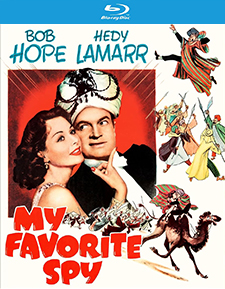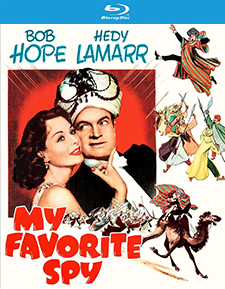My Favorite Spy (1951) (Blu-ray Review)

Director
Norman Z. McLeodRelease Date(s)
1951 (September 24, 2024)Studio(s)
Paramount Pictures (Kino Lorber Studio Classics)- Film/Program Grade: B-
- Video Grade: A
- Audio Grade: A
- Extras Grade: B
Review
Bob Hope, already a star on radio, took to the silver screen in the 1940s and early 1950s with a series of light comedies, most notably his Road pictures with Bing Crosby. Typically, he played a wise-cracking, one-liner spouting character with a spine of jelly. In My Favorite Spy, Hope is a vaudevillian with an uncanny resemblance to a violent spy.
On his way to Tangier to purchase a microfilm containing vital war secrets, foreign spy Eric Augustine (Hope) is severely wounded by the American authorities and confined in a hospital. The feds get wind that burlesque comic Peanuts White (also Hope) is the spitting image of Augustine and try to recruit him to impersonate the spy and lead them to his nefarious contacts in Tangier. It takes a $10,000 inducement and a personal phone call from the President to persuade an extremely reluctant Peanuts to accept the mission.
Schooled on how to behave like the suave, romantic Augustine and attired to look exactly like him, Peanuts is thrust into the world of espionage and international intrigue. In Tangier, he meets Augustine’s girl, the dangerous beauty Lily Dalbray (Hedy Lamarr, Samson and Delilah), who’s now collaborating with the spy’s mastermind, Karl Brubaker (Francis L. Sullivan, Oliver Twist).
The My Favorite series of films starring Hope all spoofed serious genres. My Favorite Spy is a parody of spy melodramas with Hope as its centerpiece to provide laughs. Directed by Norman Z. McLeod, the film is fast paced, but the jokes haven’t aged well. Most of Hope’s quips and verbal jokes fall flat. Hedy Lamarr as the femme fatale adds glamour and a sort of love interest for Hope. Irresistible, with an aura of danger and suspect loyalties, Lily sets up some key comic moments. Yet the character’s purpose is mostly to serve as eye candy and humorless “straight man.” Lamarr, alluring and sensual in gowns by Edith Head, adds her own star power to the picture.
Shot entirely on the Paramount lot in sets that aren’t at all convincing, the film has an almost bargain-basement look. In one sequence, Peanuts as Augustine is administered a truth serum, which affords Hope the opportunity to do some comic shtick, including performing the silly tune I Wind Up Taking a Fall with a bit of accompanying choreography. The lyrics by Johnny Mercer are intended to be witty and mesh with Hope’s brand of comedy, but instead come off as dull.
The film comes alive toward the end with an elaborate comic chase sequence worthy of the best of Buster Keaton. This lengthy scene involves a stuntman standing in for Hope and is reminiscent of the Keystone Cops shorts of the silent era. The slapstick works and some of the stunts look really dangerous. The chase is the comedic high point of the film.
My Favorite Spy is a showcase for Bob Hope. The story is slight, based on tropes of the spy thriller and touches of film noir, with ample opportunities for Hope to mug his way through. If the jokes were more finely tuned, the film could have been far funnier. Though the script does not offer his best material, you have to admire his perseverance to land the gags, and he does convey a charm based on his Everyman persona thrust into a situation far over his head. He even breaks the Fourth Wall, in a nod to the Road pictures, when he shouts during a house fire, “Tell the ushers the popcorn’s burning.” In film comedy, Hope bridged the gap between the Marx Brothers and Jerry Lewis. Seeing Hope’s films today, it’s hard to fathom how popular he once was. My Favorite Spy is a remake of the 1942 film of the same name.
My Favorite Spy was shot by director of photography Victor Milner on 35 mm black & white film with spherical lenses, finished photochemically, and presented in the Academy aspect ratio of 1.37:1. The Blu-ray is sourced from a 2020 HD master by Paramount Pictures from a 4K scan. Contrast and clarity are sharp, with details, such as Peanuts’ clownish vaudeville costume, Lily’s sparkling gowns and feathered hat, decor in the nightclub, and the Tangier sets well delineated. Lighting gives certain scenes an appropriately cloak-and-dagger look. Rear screen projection is used for the inside of a car in motion and for the climactic chase sequence.
The soundtrack is English 2.0 DTS-HD Master Audio. English subtitles are an available option. Dialogue is clear and distinct, allowing Hope’s one-liners and quips to be heard clearly. There’s an echo, a tell-tale indication that the outdoors is really an interior studio-filmed exterior. When Peanuts straightens out his extended arms, a cracking sound is heard. Fire engine sirens, car motors, an explosion, and gun shots comprise the film’s sound effects. Hedy Lamarr is dubbed by Martha Mears for Lily’s song, Just a Moment More. Victor Young’s score adds excitement to the chase sequence and mystery to scenes of the real Augustine lurking in the shadows.
Bonus materials on the Region A Blu-ray release from Kino Lorber Studio Classics include the following:
- Audio Commentary by Julie Kirgo and Peter Hankoff
- My Favorite Blonde Trailer (2:17)
- Where There’s Life Trailer (1:57)
- The Ghost Breakers Trailer (2:15)
- Never Say Die Trailer (:55)
- The Female Animal Trailer (2:10)
Audio Commentary – Film historian/writer Julie Kirgo and writer/filmmaker Peter Hankoff refer to My Favorite Spy as a film about a troublemaker. This was the third in a series that Paramount hoped would be as successful as its Road pictures. Each would star Bob Hope and a beautiful leading lady. The first was My Favorite Blonde with Madeleine Carroll, then My Favorite Brunette with Dorothy Lamour and finally My Favorite Spy with Hedy Lamarr. Hope plays the self-deprecating coward who’s always after the lady. Director Norman Z. McLeod was known for comedies such as Monkey Business (The Marx Brothers), It’s a Gift (W.C. Fields), Topper (Cary Grant), and The Secret Life of Walter Mitty (Danny Kaye). Bob Hope liked to surround himself with directors and writers he was comfortable with. His background in vaudeville is reflected in his Peanuts character. When the film was made, Hope was starting in TV with specials, not a weekly program. His career included vaudeville, radio, motion pictures, USO tours, and television. The film often “goes off on a tangent” to showcase Hope’s comedy buffoonery. The consummate entertainer, Hope embodied the Golden Age of Hollywood. At the height of his popularity, he was the largest landowner in California. He lived to the age of 100. Though he was so famous for so long, he’s now virtually unknown to younger people. Hedy Lamarr’s career is discussed from her early years in Europe, her scandalous nude appearance in Ecstasy, and her emergence as a Hollywood star. Her beauty was both a blessing and a curse, since she was also exceptionally intelligent and this was overshadowed by her looks. She developed the technology that’s used in cellphones, yet never profited from it. In later years, she became a recluse.
My Favorite Spy is mildly entertaining in its attempt to parody spy thrillers. Bob Hope is clearly the focus, with plot, characters, and situations geared to his talents. Though the screenplay by Edmund Hartmann and Jack Sher fails to provide him with the best material, the film has its merits: a first-class supporting cast, a beautiful leading lady, and a wild and wooly chase.
- Dennis Seuling

